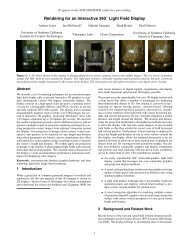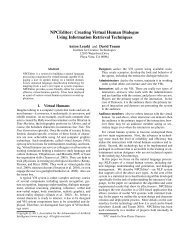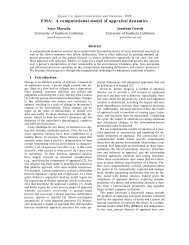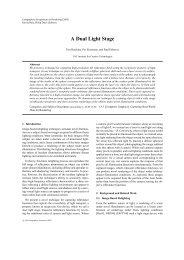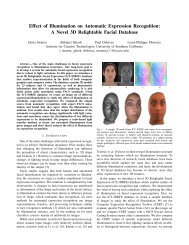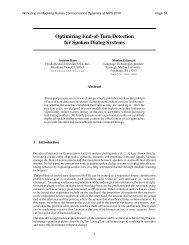Measurement-Based Synthesis of Facial ... - ICT Graphics Lab
Measurement-Based Synthesis of Facial ... - ICT Graphics Lab
Measurement-Based Synthesis of Facial ... - ICT Graphics Lab
You also want an ePaper? Increase the reach of your titles
YUMPU automatically turns print PDFs into web optimized ePapers that Google loves.
EUROGRAPHICS 2013 / I. Navazo, P. Poulin<br />
(Guest Editors)<br />
Volume 32 (2013), Number 2<br />
<strong>Measurement</strong>-<strong>Based</strong> <strong>Synthesis</strong> <strong>of</strong> <strong>Facial</strong> Microgeometry<br />
Paul Graham, Borom Tunwattanapong, Jay Busch, Xueming Yu, Andrew Jones, Paul Debevec, and Abhijeet Ghosh †<br />
USC Institute for Creative Technologies, Los Angeles, CA, USA<br />
(a) Rendering using 4K (b) Rendering using 4K (c) Rendering using synthesized (d) Comparison photograph<br />
geometry geometry and microscale BRDF microstructure<br />
Figure 1: (a) Rendering with scanned mesostructure (4K displacement map). (b) Rendering with scanned mesostructure (4K<br />
displacement map) and microstructure measured BRDF. (c) Rendering with synthesized microstructure (16K displacement<br />
map). (d) Photograph under flash illumination. See Fig. 3, Subject 2 for the skin patches used in microstructure synthesis.<br />
Abstract<br />
We present a technique for generating microstructure-level facial geometry by augmenting a mesostructure-level<br />
facial scan with detail synthesized from a set <strong>of</strong> exemplar skin patches scanned at much higher resolution. Additionally,<br />
we make point-source reflectance measurements <strong>of</strong> the skin patches to characterize the specular reflectance<br />
lobes at this smaller scale and analyze facial reflectance variation at both the mesostructure and microstructure<br />
scales. We digitize the exemplar patches with a polarization-based computational illumination technique<br />
which considers specular reflection and single scattering. The recorded microstructure patches can be used<br />
to synthesize full-facial microstructure detail for either the same subject or to a different subject. We show that the<br />
technique allows for greater realism in facial renderings including more accurate reproduction <strong>of</strong> skin’s specular<br />
reflection effects.<br />
Categories and Subject Descriptors (according to ACM CCS): I.3.7 [COMPUTER GRAPHICS]: Three-Dimensional<br />
<strong>Graphics</strong> and Realism<br />
1. Introduction<br />
products to achieve specific skin appearance results. As virtual<br />
human characters become increasingly prevalent in linear<br />
and interactive storytelling, the need for measuring, mod-<br />
The way our skin reflects light is influenced by age, genetics,<br />
health, emotion, sun exposure, substance use, and skin treatments.<br />
The importance <strong>of</strong> skin reflectance is underscored by<br />
eling, and rendering the subtleties <strong>of</strong> light reflection from<br />
skin also becomes increasingly important.<br />
the worldwide cosmetics industry which sells a myriad <strong>of</strong><br />
While great strides have been made in simulating the scattering<br />
<strong>of</strong> light beneath skin [HK93, JMLH01, DJ05, DI11],<br />
† Currently at Imperial College London somewhat less attention has been given to surface reflection.<br />
c○ 2013 The Author(s)<br />
Computer <strong>Graphics</strong> Forum c○ 2013 The Eurographics Association and Blackwell Publishing<br />
Ltd. Published by Blackwell Publishing, 9600 Garsington Road, Oxford OX4 2DQ,<br />
UK and 350 Main Street, Malden, MA 02148, USA.
Graham et al. / <strong>Measurement</strong>-<strong>Based</strong> <strong>Synthesis</strong> <strong>of</strong> <strong>Facial</strong> Microgeometry<br />
While the shine <strong>of</strong> our skin — the specular reflection from<br />
the epidermal cells <strong>of</strong> the stratum corneum — is a small fraction<br />
<strong>of</strong> the incident light, its lack <strong>of</strong> scattering provides a<br />
clear indication <strong>of</strong> skin’s surface shape and condition. And<br />
under concentrated light sources, the narrower specular lobe<br />
produces highlights which can dominate appearance, especially<br />
for smoother, oilier, or darker skin.<br />
Current face scanning techniques [WMP ∗ 06, MHP ∗ 07,<br />
BBB ∗ 10] as well as high-resolution scanning <strong>of</strong> facial casts<br />
(e.g. [XYZ], [ANCN10]) provide submillimeter precision,<br />
recording facial mesostructure at the level <strong>of</strong> pores, wrinkles,<br />
and creases. Nonetheless, the effect <strong>of</strong> surface roughness<br />
continues to shape specular reflection at the level <strong>of</strong> microstructure<br />
[TS67] — surface texture at the scale <strong>of</strong> microns.<br />
The current absence <strong>of</strong> such microstructure may be a<br />
reason why digital humans can still appear uncanny in closeups,<br />
which are the shots most responsible for conveying the<br />
thought and emotion <strong>of</strong> a character.<br />
In this work, we present a synthesis approach for increasing<br />
the resolution <strong>of</strong> mesostructure-level facial scans using<br />
surface microstructure digitized from skin samples about the<br />
face. We digitize the skin patches using macro photography<br />
and polarized gradient illumination [MHP ∗ 07] at approximately<br />
10 micron precision. Additionally, we make pointsource<br />
reflectance measurements to characterize the specular<br />
reflectance lobes at this smaller scale and analyze facial<br />
reflectance variation at both the mesostructure and microstructure<br />
scales. We then employ a constrained texture<br />
synthesis algorithm based on Image Analogies [HJO ∗ 01]<br />
to synthesize appropriate surface microstructure per-region,<br />
blending the regions to cover the whole entire face. We<br />
show that renderings made with microstructure-level geometry<br />
and reflectance models preserve the original scanned<br />
mesostructure and exhibit surface reflection which is significantly<br />
more consistent with real photographs <strong>of</strong> the face.<br />
2. Related Work<br />
Our work builds on a variety <strong>of</strong> results in skin reflectance<br />
modeling, surface detail acquisition, and texture synthesis.<br />
2.1. Skin Reflectance Modeling<br />
Physically-based models <strong>of</strong> light reflection from rough surfaces<br />
are typically based on a micr<strong>of</strong>acet distribution model<br />
[TS67, CT82]. BRDFs for rendering have been tabulated<br />
from photographed foreheads under a sampling <strong>of</strong> lighting<br />
conditions and viewing directions [MWL ∗ 99]. Using a<br />
moving light source and camera to record a bidirectional<br />
database <strong>of</strong> skin samples, a texton histogram model has been<br />
built to detect skin abnormalities [CDMR05]. Ghosh et al.<br />
[GHP ∗ 08] fit a micr<strong>of</strong>acet BRDF model [APS00] to specular<br />
reflectance data across various patches <strong>of</strong> human faces<br />
from high-resolution surface orientation measurements.<br />
We acquire detailed surface shape and reflectance <strong>of</strong> example<br />
skin patches to increase the resolution <strong>of</strong> a largerscale<br />
model. This approach echoes other work which extrapolates<br />
detailed samples <strong>of</strong> reflectance over complete models,<br />
including sampling subsurface scattering parameters with<br />
a special probe [WMP ∗ 06], and using a BRDF probe to<br />
add detailed BRDFs to entire objects observed in relatively<br />
few lighting conditions [DWT ∗ 10]. Our work also relates<br />
to basis BRDF modeling [LKG ∗ 03] and reflectance sharing<br />
[ZREB06].<br />
2.2. Surface Detail <strong>Measurement</strong><br />
Key to our work is measuring surface detail from images<br />
taken with a fixed viewpoint and varying lighting. Classic<br />
photometric stereo [Woo78] derives surface orientations<br />
<strong>of</strong> Lambertian surfaces from three point-light directions.<br />
Bump maps produced from photometric stereo have been<br />
used to increase the detail on rendered surfaces [RTG97].<br />
For semi-translucent materials such as skin, subsurface scattering<br />
blurs the surface detail recoverable from traditional<br />
photometric stereo significantly [RR08]. Specular surface<br />
reflection analysis has been used to obtain more precise<br />
surface orientation measurements <strong>of</strong> translucent materials<br />
[DHT ∗ 00, RR08, WMP ∗ 06, CGS06]. Ma et al. [MHP ∗ 07]<br />
uses polarization difference imaging to isolate the specular<br />
reflection under gradient lighting conditions, allowing specular<br />
surface detail to be recorded in a small number <strong>of</strong> images.<br />
The GelSight system [JCRA11] pushes silver-coated<br />
gel against a sample and uses photometric stereo to record<br />
surface microgeometry at the level <strong>of</strong> a few microns. While<br />
this setup achieves the resolution required for our technique,<br />
it does not enable reflectance measurements. In our work, we<br />
measure microgeometry using a polarized gradient illumination<br />
technique [GFT ∗ 11] since it requires no contact with<br />
the sample and permits the material’s actual reflectance to be<br />
observed during measurement for BRDF fitting.<br />
2.3. Texture <strong>Synthesis</strong><br />
Wei et al. [WLKT09] compiled a recent review <strong>of</strong> examplebased<br />
texture synthesis. To summarize a few results, 2D texture<br />
synthesis algorithms [HB95, EL99] have been extended<br />
to arbitrary manifold surfaces [WL01, YHBZ01, LH06]<br />
and can also synthesize displacement maps [YHBZ01],<br />
measured reflectance properties [TZL ∗ 02] and skin color<br />
[TOS ∗ 03]. Some techniques [EF01, HJO ∗ 01] permit texture<br />
transfer, transforming a complete image so that it has textural<br />
detail <strong>of</strong> a given sample. Super-resolution techniques<br />
add detail to a low-resolution image based on examples<br />
[HJO ∗ 01, FJP02, LH05]. Especially relevant to our work<br />
are constrained texture synthesis techniques [WM04, RB07]<br />
which add plausible detail to a low-resolution image without<br />
changing its low frequency content. In our work, we adapt<br />
the Image Analogies [HJO ∗ 01] framework to perform conc○<br />
2013 The Author(s)<br />
c○ 2013 The Eurographics Association and Blackwell Publishing Ltd.
Graham et al. / <strong>Measurement</strong>-<strong>Based</strong> <strong>Synthesis</strong> <strong>of</strong> <strong>Facial</strong> Microgeometry<br />
strained texture synthesis <strong>of</strong> skin microstructure onto facial<br />
scans while preserving scanned facial mesostructure.<br />
Some techniques have been proposed to increase the detail<br />
present in facial images and models, although at significantly<br />
coarser resolution than we address in our work. Face<br />
hallucination [LSZ01] creates recognizable facial images by<br />
performing constrained facial texture synthesis onto a parametric<br />
face model. Image processing applies facial detail<br />
from one subject to another, allowing image-based aging effects<br />
[LZS04]. Most closely related to our work is Golovinskiy<br />
et al. [GMP ∗ 06], which synthesizes skin mesostructure<br />
(but not microstructure) from higher-quality facial scans<br />
onto otherwise smooth facial shapes. In addition to working<br />
at a very different scale than our work (we assume that<br />
wrinkles, creases, and larger pores are already apparent in<br />
the source scan), the synthesis method is based on matching<br />
per-region frequency statistics rather than patch-based<br />
texture synthesis, and is not designed to match to existing<br />
mesostructure.<br />
Our process <strong>of</strong> sampling skin microgeometry follows recent<br />
work which models or measures materials at the micro<br />
scale in order to better predict their appearance at normally<br />
observable larger scales. Observations <strong>of</strong> a cross-section <strong>of</strong><br />
wood from an electron micrograph have motivated reflection<br />
models which better predicted anisotropic reflection effects<br />
[MWAM05]. Direct use <strong>of</strong> Micro CT imaging <strong>of</strong> fabric<br />
samples have been used to model the volumetric scattering<br />
<strong>of</strong> complete pieces <strong>of</strong> cloth [ZJMB11].<br />
3. Recording Skin Microstructure<br />
3.1. Acquisition<br />
We record the microstructure <strong>of</strong> skin patches using one <strong>of</strong><br />
two systems to create polarized gradient illumination. For<br />
both, we stabilize the skin patch relative to the camera by<br />
having the subject place their skin against a 24mm × 16mm<br />
aperture in a thin metal plate. This plate is firmly secured<br />
30cm in front <strong>of</strong> the sensor <strong>of</strong> a Canon 1D Mark III camera<br />
with a Canon 100mm macro lens stopped down to f/16,<br />
just enough depth <strong>of</strong> field to image the sample when properly<br />
focused. The lens achieves 1:1 macro magnification, so<br />
each pixel <strong>of</strong> the 28mm × 19mm sensor images about seven<br />
square microns (7µm 2 ) <strong>of</strong> skin.<br />
Our small capture system (Fig. 2(a)) is a 12-light dome<br />
(half <strong>of</strong> a deltoidal icositetrahedron) similar to those used<br />
for acquiring Polynomial Texture Maps [MGW01], with the<br />
addition that each light can produce either <strong>of</strong> two linear polarization<br />
conditions. We modified the polarization orientations<br />
<strong>of</strong> a multiview polarization pattern [GFT ∗ 11] such that<br />
each light is specifically optimized for a single viewpoint.<br />
The difference between images acquired under parallel and<br />
cross polarized states records the polarization-preserving reflectance<br />
<strong>of</strong> the sample, attenuating subsurface reflectance.<br />
In approximately two seconds, we acquire polarized gradient<br />
illumination conditions to record surface normals. We compensate<br />
for any subject motion using joint photometric alignment<br />
[WGP ∗ 10]. For BRDF fitting, we additionally capture<br />
a single-light image in both polarized lighting conditions.<br />
(a)<br />
Figure 2: Acquisition setups for skin microgeometry (a) 12-<br />
light hemispherical dome (at end <strong>of</strong> camera lens) capturing<br />
a cheek patch. (b) LED sphere capturing the tip <strong>of</strong> the nose,<br />
with the camera inside the sphere.<br />
For especially smooth or oily skin patches, the 12 light positions<br />
can produce separated specular highlights, which can<br />
bias surface normal measurement. To address this, we placed<br />
the macro photography camera and metal aperture frame<br />
inside the same 2.5m-diameter polarized LED sphere used<br />
for facial scanning (Fig. 2(b)). While the camera occludes<br />
some light directions from reaching the sample, the hemispherical<br />
coverage <strong>of</strong> the incident light directions is denser<br />
and more complete than the 12-light setup, allowing the gradient<br />
illumination to yield well-conditioned surface normal<br />
measurements for all patches we tested. Since a single LED<br />
light source was not bright enough to illuminate the sample<br />
for specular BRDF observation, a pair <strong>of</strong> horizontally and<br />
vertically polarized camera flashes (Canon Speedlite 580EX<br />
II) were fired to record the point-light condition from close<br />
to the normal direction. The camera mounts in both setups<br />
were reinforced to remove mechanically vibrations and flexing<br />
which would blur the captured imagery.<br />
3.2. Surface Normal and BRDF Estimation<br />
We compute a per-pixel surface orientation map from the polarized<br />
gradients, as well as specular and subsurface albedo<br />
maps. Figure 3 shows the geometry <strong>of</strong> five skin patches digitized<br />
for two subjects, including regions <strong>of</strong> the forehead,<br />
temple, cheek, nose, and chin. Due to the flat nature <strong>of</strong> the<br />
skin patches, we only visualize the x and y components <strong>of</strong><br />
the surface normals with yellow and cyan colors respectively.<br />
Note that the skin microstructure is highly differentiated<br />
across both individuals and facial regions.<br />
Using the polarization difference point-lit image, we also<br />
tabulate a specular lobe shape and single scattering model<br />
parameters [GHP ∗ 08]. With light pressure, the skin protrudes<br />
slightly through the metal aperture frame, providing a<br />
slightly convex surface which exhibits a useful range <strong>of</strong> surface<br />
normals for BRDF estimation. Using a specular BRDF<br />
(b)<br />
c○ 2013 The Author(s)<br />
c○ 2013 The Eurographics Association and Blackwell Publishing Ltd.
Subject 1<br />
Graham et al. / <strong>Measurement</strong>-<strong>Based</strong> <strong>Synthesis</strong> <strong>of</strong> <strong>Facial</strong> Microgeometry<br />
(a) Photograph<br />
(b) Rendering<br />
Subject 2<br />
(c) Photograph<br />
(d) Rendering<br />
(a) forehead (b) temple (c) cheek (d) nose (e) chin<br />
Figure 3: Measured skin patches from different facial regions<br />
<strong>of</strong> two different subjects. (Top two rows) Caucasian<br />
male subject. (Bottom two rows) Asian female subject. (Rows<br />
one and three) Surface normals. (Rows two and four) Displacements.<br />
model [TS67], we found that two lobes <strong>of</strong> a Beckmann distribution<br />
[CT82] fit the data well. In order to better fit the specular<br />
and single scattering model parameters, we factor the<br />
observed polarization-preserving reflection under constant<br />
full-on illumination into two separate specular and single<br />
scattering albedo maps. Here, we estimate the single scattering<br />
albedo as the difference between observed polarization<br />
preserving reflectance and average hemispherical specular<br />
reflectance <strong>of</strong> a dielectric surface with index <strong>of</strong> refraction<br />
η = 1.33, which is about 0.063.<br />
Figures 4 and 5 show skin patch samples and validation<br />
renderings made using the estimated subsurface albedo,<br />
specular albedo, specular normals, and specular BRDF,<br />
showing close visual matches <strong>of</strong> the model to the photographs.<br />
At this scale, where much <strong>of</strong> the surface roughness<br />
variation is evident geometrically, we found that a single<br />
two-lobe specular BRDF estimate to be sufficient over<br />
each sample, and that variation in the reflectance parameter<br />
fits were quite modest (see Table 1) compared to the differences<br />
observed at the mesostructure scale (see Table 2).<br />
4. <strong>Facial</strong> Microstructure <strong>Synthesis</strong><br />
From the skin microstructure samples, we employ constrained<br />
texture synthesis to generate skin microstructure for<br />
an entire face. To do this, we use the surface mesostructure<br />
evident in a full facial scan to guide the texture synthesis process<br />
for each facial region, and then merge the synthesized<br />
facial regions into a full map <strong>of</strong> the microstructure.<br />
We begin with full facial scans recorded using a multiview<br />
Figure 4: (a) Parallel-polarized photograph <strong>of</strong> a forehead<br />
skin patch <strong>of</strong> a male subject, lit slightly from above. (b) Validation<br />
rendering <strong>of</strong> the patch under similar lighting using<br />
the surface normals, specular albedo, diffuse albedo, and<br />
single scattering maps estimated from the 12-light dome,<br />
showing visual similarity. (c,d) Similar images from a different<br />
light source direction.<br />
(a) Photograph<br />
(c) Photograph<br />
(b) Rendering<br />
(d) Rendering<br />
Figure 5: (a) Parallel-polarized photograph <strong>of</strong> a cheek<br />
patch for a female subject, lit slightly from above. (b) Validation<br />
rendering <strong>of</strong> the cheek patch lit from a similar direction<br />
using reflectance maps estimated from the LED sphere,<br />
showing a close match. (c,d) Corresponding images from<br />
subject’s nose patch, also showing a close match.<br />
polarized gradient illumination technique [GFT ∗ 11], which<br />
produces an ear-to-ear polygon mesh <strong>of</strong> approximately five<br />
million polygons, 4K (4096 × 4096 pixel) diffuse and specular<br />
albedo maps, and a world-space normal map. We believe<br />
our technique could also work with other high-resolution facial<br />
capture techniques [BBB ∗ 10, XYZ].<br />
We create the texture coordinate space for the facial scan<br />
using the commercial product Unfold3D in a way which best<br />
preserves surface area and orientation with respect to the<br />
c○ 2013 The Author(s)<br />
c○ 2013 The Eurographics Association and Blackwell Publishing Ltd.
Graham et al. / <strong>Measurement</strong>-<strong>Based</strong> <strong>Synthesis</strong> <strong>of</strong> <strong>Facial</strong> Microgeometry<br />
Figure 6: A world-space normal map from the Subject 1 facial<br />
scan, segmented into regions for texture synthesis.<br />
A<br />
B<br />
original scan. This allows us to assume that the relative scale<br />
and orientation <strong>of</strong> the patches is constant with respect to the<br />
texture space; if this were not the case, then an anisometric<br />
texture synthesis technique [LH06] could be employed.<br />
We transform the normal map to tangent space, and use<br />
multiresolution normal integration to construct the 4K displacement<br />
map which best agrees with the normal map.<br />
An artist segments this map into forehead, temples, nose,<br />
cheeks, and chin regions (Fig. 6). Regions overlap enough<br />
so they can be blended together using linear-interpolation.<br />
To synthesize appropriate skin microstructure over the<br />
mesostructure present in our facial scans, we employ constrained<br />
texture synthesis in the framework <strong>of</strong> Image Analogies<br />
[HJO ∗ 01], which synthesizes an image B ′ from an image<br />
B following the relationship <strong>of</strong> a pair <strong>of</strong> example images<br />
A and A ′ . In our case, B is the mesostructure-level displacement<br />
map for a region <strong>of</strong> the face, such as the forehead<br />
or cheek (see Fig. 7). Our goal is to synthesize B ′ , a<br />
higher-resolution <strong>of</strong> this region exhibiting appropriate microstructure.<br />
We form the A to A ′ analogy by taking an exemplar<br />
displacement map <strong>of</strong> the microstructure <strong>of</strong> a related<br />
skin patch to be A ′ . The exemplar patch A ′ typically covers<br />
less than a square centimeter <strong>of</strong> skin surface, but at about<br />
ten times the resolution <strong>of</strong> the mesostructure detail. To form<br />
A, we blur the exemplar A ′ with a Gaussian filter to suppress<br />
the high frequencies not present in the input mesostructure<br />
map B. A thus represents the mesotructure <strong>of</strong> the exemplar.<br />
The synthesis process then proceeds in the image<br />
analogies framework to produce the output surface shape<br />
B ′ , with both mesostructure and microstructure, given the<br />
input mesostructure B, and the pair <strong>of</strong> exemplars relating<br />
mesostructure A to its microstructure A ′ .<br />
As values from A ′ replace values in B, it is possible for<br />
the low-to-medium frequency mesostructure <strong>of</strong> B to be unintentionally<br />
replaced with mesostructure from A ′ . To ensure<br />
preservation <strong>of</strong> mesostructure details in the scan data,<br />
we run a high-pass filter on both the input and the exem-<br />
A’ B’<br />
Figure 7: Microstructure <strong>Synthesis</strong> We add microstructural<br />
detail to a scanned facial region, B, using the analogous relationship<br />
between an exemplar microstructure map, A ′ , and<br />
a blurred version <strong>of</strong> it, A, which matches the mesostructural<br />
detail <strong>of</strong> B. The synthesized result with both mesostructure<br />
and microstructure is B ′ . These displacement maps are from<br />
the temple region <strong>of</strong> a female subject.<br />
plar displacement maps. This technique separates the lowto-medium<br />
frequency features from the high-frequency features,<br />
allowing the medium frequency features present in the<br />
high pass <strong>of</strong> B to guide the synthesis <strong>of</strong> the high-frequency<br />
features from A ′ . We then recombine the frequencies to obtain<br />
a final result.<br />
Our synthesis process employs a similar BestApproximateMatch<br />
based on an approximate-nearest-neighbor<br />
(ANN) search and BestCoherenceMatch based on<br />
Ashikhmin [Ash01]. However, we introduce a weighting<br />
parameter α to control the relative importance <strong>of</strong> a<br />
pixel neighborhood in A ′ matching B ′ compared to the<br />
importance (1 − α) <strong>of</strong> the match between the corresponding<br />
pixel neighborhood in B and A. We found this to be a useful<br />
control parameter because certain visually important details<br />
c○ 2013 The Author(s)<br />
c○ 2013 The Eurographics Association and Blackwell Publishing Ltd.
Graham et al. / <strong>Measurement</strong>-<strong>Based</strong> <strong>Synthesis</strong> <strong>of</strong> <strong>Facial</strong> Microgeometry<br />
that exist in A ′ can be entirely absent in the lower frequency<br />
mesostructures maps A and B. We found that an α value<br />
around 0.5 produced good results.<br />
We carry out the texture synthesis in a multiresolution<br />
fashion, increasing the window size for the neighborhood<br />
matching from a 5 × 5 pixel window at the lowest level (4K<br />
resolution) to a 13 × 13 pixel window at the highest level<br />
(16K resolution) to match the increase in size <strong>of</strong> features at<br />
each level <strong>of</strong> the synthesis. We also apply principle component<br />
analysis (PCA) in order to speed up the synthesis. We<br />
use PCA to reduce the dimensionality <strong>of</strong> the search space to<br />
n, where n × n is the original pixel window. PCA reduced<br />
the synthesis time by a factor <strong>of</strong> three without any qualitative<br />
decreases in the result. We employ equal weighting<br />
to BestApproximateMatch and BestCoherenceMatch by setting<br />
the coherence parameter κ = 1 in the synthesis process.<br />
Since the specular albedo map is highly correlated to the surface<br />
mesostructure and microstructure, we also synthesize a<br />
16K specular albedo map as a by-product <strong>of</strong> the microstructure<br />
displacement synthesis process by borrowing the corresponding<br />
pixels from the specular albedo exemplar.<br />
5. Results<br />
5.1. Creating Renderings<br />
Once we have synthesized microstructure-level displacement<br />
maps for a face, we can create renderings using the<br />
subsurface albedo, specular albedo, and single scattering coefficients<br />
using any standard rendering technique. To generate<br />
the renderings in this section, we use a local specular<br />
reflection model with two lobes per skin region estimated<br />
as described in Section 3. For efficiency, the subsurface reflection<br />
is simulated using a hybrid normals rendering technique<br />
[MHP ∗ 07] from the gradient illumination data <strong>of</strong> the<br />
full facial scan, though in practice a true scattering simulation<br />
would be preferable. Single scattering, estimated from<br />
the exemplars, is also rendered [GHP ∗ 08]. We upscaled the<br />
original scanned data to fill in the regions where we did not<br />
synthesize microgeometry (lips, neck, eye brows, etc). For<br />
the upper eyelids, we synthesised microstructure using the<br />
measured forehead microstructure exemplar.<br />
5.2. Image Sizes and Resampling<br />
In the rendering process, the subsurface albedo and subsurface<br />
normal maps remain at the original 4K resolution <strong>of</strong><br />
the facial scan, as does the polygon geometry. The synthesized<br />
16K microstructure displacement map is converted to<br />
a normal map for rendering and used in conjunction with<br />
the 16K synthesized specular albedo map. To avoid artifacts<br />
from normal map resampling or aliasing, full-face renderings<br />
are created using an OpenGL GPU shader to a large<br />
16K (16384×16384 pixels) half float frame buffer, and then<br />
resized to 4K using radiometrically linear pixel blending, requiring<br />
approximately 1GB <strong>of</strong> GPU memory.<br />
Fig. 1 shows a high-resolution point-light rendering <strong>of</strong> a<br />
female subject using a synthesized 16K microstructure displacement<br />
map (c) compared to using just the 4K mesostructure<br />
displacement map from the original scan (a) and a 4k<br />
rendering using the microscale measured BRDF (b) as well<br />
as a reference photograph under flash illumiation (d). The<br />
16K rendering includes more high-frequency specular detail,<br />
and better exhibits skin’s characteristic effect <strong>of</strong> isolated<br />
"glints" far away from the center <strong>of</strong> the specular highlight. A<br />
similar result is shown in Fig. 8 where a point-light rendering<br />
<strong>of</strong> a male subject’s forehead using synthesized microstructure<br />
is a better match to a validation photograph compared<br />
to the rendering <strong>of</strong> the original scan with mesostructure detail.<br />
Fig. 9 shows displacement maps (top row), normal maps<br />
(x and y components only, middle row), and point-light<br />
renderings (bottom row) <strong>of</strong> a male forehead region generated<br />
with different synthesis processes. Fig. 9(a) shows a<br />
region from an original mesostructure-only scan, with no<br />
synthesis to add microstructure detail. The specular reflection,<br />
rendered with corresponding mesoscale BRDF fit, is<br />
quite smooth as a result, and the skin reflection is not especially<br />
realistic. Fig. 9(b) shows the result <strong>of</strong> our microstructure<br />
synthesis process using an exemplar skin patch measurement<br />
from the same subject (the forehead <strong>of</strong> Subject 1<br />
in Fig. 3(a)). The specular reflection, rendered with a microscale<br />
BRDF fit, is broken up and shows greater surface<br />
detail, while the mesostructure <strong>of</strong> the forehead crease is preserved.<br />
Fig. 9(c) shows the result <strong>of</strong> using a forehead patch<br />
from a different male subject as the exemplar for adding microstructure.<br />
Although the fine skin texture is different, the<br />
synthesized geometry and rendering is still very plausible,<br />
suggesting cross-subject microstructure synthesis to be a viable<br />
option.<br />
Fig. 9(d) tests the importance <strong>of</strong> the mesostructure constraints<br />
during texture synthesis. This column was generated<br />
by setting the α parameter to 1.0, ignoring mesostructure<br />
matching constraints in the matching process, and then<br />
blindly embossing the synthesized detail onto the mesostructure<br />
<strong>of</strong> the original scan. Fig. 9(b), however, synthesizes detail<br />
in a way which tries to follow the mesostructure, so pores<br />
and creases in the scan will tend to draw upon similar areas<br />
in the microstructure exemplar for their detail. As a result,<br />
the constrained synthesis, column (Fig. 9(b)), produces<br />
a more plausible result which better reinforces the scanned<br />
mesostructure than the texture synthesis column (Fig. 9(d)).<br />
Table 1 shows specular BRDF lobe fits for different skin<br />
patches across two subjects measured using our microstructure<br />
skin patch measurement setups. Table 2 presents comparison<br />
Beckmann distribution fits for similar facial regions<br />
obtained at the mesostructure scale from a face scan. Table 3<br />
shows the results <strong>of</strong> a cross-verification done by low-pass<br />
filtering the skin patches and measuring the BRDF fits at<br />
a "mesostructure scale." The parameter w is the weight <strong>of</strong><br />
c○ 2013 The Author(s)<br />
c○ 2013 The Eurographics Association and Blackwell Publishing Ltd.
Graham et al. / <strong>Measurement</strong>-<strong>Based</strong> <strong>Synthesis</strong> <strong>of</strong> <strong>Facial</strong> Microgeometry<br />
(a) Rendering using original scan (b) Rendering using synthesized microstructure (c) Comparison photograph<br />
Figure 8: Renderings <strong>of</strong> original facial scan with mesostructure detail (a), and with synthesized microgeometry (b) compared<br />
to to a photograph under flash illumination (c). See Fig. 3, Subject 1 for the skin patches used in microstructure synthesis.<br />
(a) Original (b) Same-subject (c) Cross-subject (d) Unconstrained<br />
Mesostructure Mesostructure Mesostructure Mesostructure<br />
Figure 9: Microstructure synthesis with different exemplars and constraints. The top row shows displacement maps, the middle<br />
row shows normal maps and the bottom row shows point-light renderings using the maps. (a) Original mesostructure. (b)<br />
With microstructure synthesized from the same subject. (c) With microstructure synthesized from a different subject. (d) Without<br />
constraining the synthesis to match the underlying mesostructure.<br />
the convex combination <strong>of</strong> the two lobes m1 and m2. As<br />
can be seen, the BRDF lobes estimates at the microstructure<br />
scale exhibit reduced specular roughness compared to the<br />
mesostructure scale BRDF estimate as well as significantly<br />
less variation across skin patches. This agrees with the theory<br />
that at sufficiently high resolution, the surface microgeometry<br />
variation is responsible for the appearance <strong>of</strong> specular<br />
roughness. Table 3 confirms that low-pass filtering the<br />
microstructure also results in BRDF fits with wider roughness,<br />
similar to the mesostructure scale BRDF fits.<br />
Fig. 10 shows comparison renderings <strong>of</strong> a small patch<br />
<strong>of</strong> forehead shown in Fig. 9, at different scales <strong>of</strong> modeling.<br />
The original scanned data with mesostructure detail and<br />
mesoscale BRDF fit results in a broad specular reflection<br />
that misses the sharp "glints" (a). Rendering the scanned<br />
mesoscale surface detail with a microscale BRDF fit results<br />
in a qualitiative improvement in the result at this scale <strong>of</strong> vic○<br />
2013 The Author(s)<br />
c○ 2013 The Eurographics Association and Blackwell Publishing Ltd.
Graham et al. / <strong>Measurement</strong>-<strong>Based</strong> <strong>Synthesis</strong> <strong>of</strong> <strong>Facial</strong> Microgeometry<br />
Description Subject 1 Subject 2<br />
forehead m1=0.150, m2=0.050, w=0.88 m1=0.150, m2=0.050, w=0.60<br />
temple m1=0.150, m2=0.075, w=0.55 m1=0.175, m2=0.050, w=0.80<br />
cheek m1=0.150, m2=0.125, w=0.60 m1=0.100, m2=0.075, w=0.50<br />
nose m1=0.100, m2=0.075, w=0.80 m1=0.100, m2=0.050, w=0.50<br />
chin m1=0.125, m2=0.100, w=0.90 m1=0.150, m2=0.050, w=0.75<br />
Table 1: Microscale two-lobe Beckmann distribution parameters<br />
obtained for the different skin patches across two<br />
subjects <strong>of</strong> Fig. 3.<br />
Description Subject 1 Subject 2<br />
forehead m1=0.250, m2=0.125, w=0.85 m1=0.250, m2=0.125, w=0.80<br />
temple m1=0.225, m2=0.125, w=0.80 m1=0.225, m2=0.150, w=0.70<br />
cheek m1=0.275, m2=0.200, w=0.60 m1=0.225, m2=0.150, w=0.50<br />
nose m1=0.175, m2=0.100, w=0.65 m1=0.150, m2=0.075, w=0.80<br />
chin m1=0.250, m2=0.150, w=0.35 m1=0.300, m2=0.225, w=0.15<br />
Table 2: Mesoscale two-lobe Beckman distribution parameters<br />
obtained for different facial regions across two subjects<br />
Description Subject 1 Subject 2<br />
forehead m1=0.175, m2=0.150, w=0.60 m1=0.225, m2=0.100, w=0.60<br />
temple m1=0.200, m2=0.125, w=0.95 m1=0.225, m2=0.200, w=0.30<br />
cheek m1=0.225, m2=0.200, w=0.60 m1=0.275, m2=0.125, w=0.45<br />
nose m1=0.175, m2=0.125, w=0.95 m1=0.125, m2=0.050, w=0.85<br />
chin m1=0.225, m2=0.200, w=0.75 m1=0.325, m2=0.150, w=0.70<br />
Table 3: Cross validation <strong>of</strong> microscale two-lobe distibution<br />
done at mesoscale resolution<br />
asperity scattering [KP03] it contributes to skin reflectance.<br />
We believe that side lighting conditions during skin measurement<br />
could allow the hairs to be isolated, and models <strong>of</strong><br />
the hairs could be added onto the synthesized textures, further<br />
increasing realism. It would also be <strong>of</strong> interest to record<br />
the effects <strong>of</strong> cosmetics on skin reflectance at the microstructure<br />
scale, potentially enabling accurate simulations <strong>of</strong> cosmetic<br />
applications.<br />
sualization (b). However, the specular reflection still appears<br />
a bit too smooth to be realistic. Rendering with synthesized<br />
microstructure in conjunction with the microscale BRDF fit<br />
achieves the best qualitiative rendering result (c).<br />
Figure 11 provides renderings <strong>of</strong> faces with synthesized<br />
microstructure at 16K resolution. The renderings were created<br />
at 16K and filtered down to 4K for presentation. Here,<br />
we simulate a "parallel polarized" point lighting condition in<br />
order to accentuate the observed specular highlights.<br />
(a)<br />
Figure 12: (a) 15mm × 10mm forehead patch from a neutral<br />
expression, with marked reference point. (b) The same<br />
forehead patch with a raised-eyebrows expression, exhibiting<br />
anisotropic microstructure, with submillimeter furrows.<br />
(b)<br />
(a) Mesoscale scan (b) Mesoscale scan (c) Microscale scan<br />
with Microscale BRDF BRDF<br />
Figure 10: Rendering original scan data (geometry + BRDF<br />
fit) (a), compared to rendering scanned geometry with microscale<br />
BRDF fit (b), and rendering with synthesized microstructure<br />
+ microscale BRDF fit (c).<br />
6. Future Work<br />
Our results suggest several avenues for future work. The efficiency<br />
<strong>of</strong> our texture synthesis and rendering algorithms<br />
could clearly be increased using GPU acceleration with<br />
more advanced texture synthesis algorithms and acceleration<br />
transformations such as appearance-space texture synthesis<br />
[LH06] and PatchMatch [BSFG09]. We do not yet address<br />
real-time rendering, for which GPU-accelerated normal<br />
distribution functions [TLQ ∗ 05, HSRG07] will be required.<br />
The complexity <strong>of</strong> skin microstructure may benefit<br />
from techniques developed for rendering especially highfrequency<br />
normal distributions such as car paint [RSK09].<br />
We currently ignore the face’s velvety fine hair and the<br />
Since actors are scanned in a variety <strong>of</strong> expressions, it<br />
would be <strong>of</strong> interest to synthesize consistent microstructure<br />
across expressions. This may not be straightforward, as we<br />
can observe that microstructure changes dramatically as skin<br />
stretches and contracts (Fig. 12) in the course <strong>of</strong> expression<br />
formation. We believe that recording skin microstructure under<br />
calibrated amounts <strong>of</strong> stress and shear will be useful for<br />
microstructure dynamics simulation, increasing the realism<br />
<strong>of</strong> animated digital characters.<br />
7. Conclusion<br />
In this work, we have presented a practical technique for<br />
adding microstructure-level detail to high-resolution facial<br />
scans, as well as microscale skin BRDF analysis, allowing<br />
renderings to exhibit considerably more realistic patterns <strong>of</strong><br />
specular reflection. We believe this produces a significant<br />
improvement in the realism <strong>of</strong> computer-generated digital<br />
characters. Our initial experiments with cross-subject microstructure<br />
synthesis also suggests the applicability <strong>of</strong> this<br />
technique to a wide variety <strong>of</strong> facial scans using a small<br />
database <strong>of</strong> measured microgeometry exemplars.<br />
8. Acknowledgments<br />
We would like to thank Rupa Upadhyay and Connie Siu for<br />
sitting as subjects; Kathleen Haase, Bill Swartout, Randy<br />
c○ 2013 The Author(s)<br />
c○ 2013 The Eurographics Association and Blackwell Publishing Ltd.
Graham et al. / <strong>Measurement</strong>-<strong>Based</strong> <strong>Synthesis</strong> <strong>of</strong> <strong>Facial</strong> Microgeometry<br />
Figure 11: Renderings from 16K displacement maps with synthesized microstructure. See supplemental material for high resolution<br />
images<br />
Hill, and Randolph Hall for their support and assistance with<br />
this work. We also thank our reviewers for their helpful suggestions<br />
and comments. This work was sponsored in part<br />
by NSF grant IIS-1016703, the University <strong>of</strong> Southern California<br />
Office <strong>of</strong> the Provost and the U.S. Army Research,<br />
Development, and Engineering Command (RDECOM). The<br />
content <strong>of</strong> the information does not necessarily reflect the<br />
position or the policy <strong>of</strong> the US Government, and no <strong>of</strong>ficial<br />
endorsement should be inferred.<br />
References<br />
[ANCN10] ACEVEDO G., NEVSHUPOV S., COWELY J., NOR-<br />
RIS K.: An accurate method for acquiring high resolution skin<br />
displacement maps. In ACM SIGGRAPH 2010 Talks (New York,<br />
NY, USA, 2010), SIGGRAPH ’10, ACM, pp. 4:1–4:1. 2<br />
[APS00] ASHIKHMIN M., PREMOZE S., SHIRLEY P. S.: A<br />
micr<strong>of</strong>acet-based BRDF generator. In Proceedings <strong>of</strong> ACM SIG-<br />
GRAPH 2000 (2000), pp. 65–74. 2<br />
[Ash01] ASHIKHMIN M.: Synthesizing natural textures. In Proceedings<br />
<strong>of</strong> the 2001 symposium on Interactive 3D graphics<br />
(New York, NY, USA, 2001), I3D ’01, ACM, pp. 217–226. 5<br />
[BBB ∗ 10] BEELER T., BICKEL B., BEARDSLEY P., SUMNER<br />
B., GROSS M.: High-quality single-shot capture <strong>of</strong> facial geometry.<br />
ACM Trans. Graph. 29 (July 2010), 40:1–40:9. 2, 4<br />
[BSFG09] BARNES C., SHECHTMAN E., FINKELSTEIN A.,<br />
GOLDMAN D. B.: Patchmatch: a randomized correspondence<br />
algorithm for structural image editing. ACM Trans. Graph. 28<br />
(July 2009), 24:1–24:11. 8<br />
[CDMR05] CULA O. G., DANA K. J., MURPHY<br />
F. P., RAO B. K.: Skin texture modeling. International<br />
Journal <strong>of</strong> Computer Vision 62 (2005), 97–119.<br />
10.1023/B:VISI.0000046591.79973.6f. 2<br />
[CGS06] CHEN T., GOESELE M., SEIDEL H. P.: Mesostructure<br />
from specularities. In CVPR (2006), pp. 1825–1832. 2<br />
[CT82] COOK R. L., TORRANCE K. E.: A reflectance model for<br />
computer graphics. ACM TOG 1, 1 (1982), 7–24. 2, 4<br />
[DHT ∗ 00] DEBEVEC P., HAWKINS T., TCHOU C., DUIKER H.-<br />
P., SAROKIN W., SAGAR M.: Acquiring the reflectance field <strong>of</strong><br />
a human face. In ACM SIGGRAPH (2000). 2<br />
[DI11] D’EON E., IRVING G.: A quantized-diffusion model<br />
for rendering translucent materials. In ACM SIGGRAPH 2011<br />
papers (New York, NY, USA, 2011), SIGGRAPH ’11, ACM,<br />
pp. 56:1–56:14. 1<br />
[DJ05] DONNER C., JENSEN H. W.: Light diffusion in multilayered<br />
translucent materials. ACM TOG 24, 3 (2005), 1032–<br />
1039. 1<br />
[DWT ∗ 10] DONG Y., WANG J., TONG X., SNYDER J., LAN Y.,<br />
BEN-EZRA M., GUO B.: Manifold bootstrapping for svbrdf capture.<br />
ACM Transactions on <strong>Graphics</strong> 29, 4 (July 2010), 98:1–<br />
98:10. 2<br />
[EF01] EFROS A. A., FREEMAN W. T.: Image quilting for texture<br />
synthesis and transfer. In Proceedings <strong>of</strong> the 28th annual<br />
conference on Computer graphics and interactive techniques<br />
(New York, NY, USA, 2001), SIGGRAPH ’01, ACM, pp. 341–<br />
346. 2<br />
[EL99] EFROS A. A., LEUNG T. K.: Texture synthesis by nonparametric<br />
sampling. In Proceedings <strong>of</strong> the International Conference<br />
on Computer Vision-Volume 2 - Volume 2 (Washington,<br />
DC, USA, 1999), ICCV ’99, IEEE Computer Society, pp. 1033–.<br />
2<br />
[FJP02] FREEMAN W., JONES T., PASZTOR E.: Example-based<br />
super-resolution. Computer <strong>Graphics</strong> and Applications, IEEE 22,<br />
2 (mar/apr 2002), 56 –65. 2<br />
[GFT ∗ 11] GHOSH A., FYFFE G., TUNWATTANAPONG B.,<br />
BUSCH J., YU X., DEBEVEC P.: Multiview face capture using<br />
polarized spherical gradient illumination. In Proceedings <strong>of</strong> the<br />
2011 SIGGRAPH Asia Conference (New York, NY, USA, 2011),<br />
SA ’11, ACM, pp. 129:1–129:10. 2, 3, 4<br />
[GHP ∗ 08] GHOSH A., HAWKINS T., PEERS P., FREDERIKSEN<br />
S., DEBEVEC P.: Practical modeling and acquisition <strong>of</strong> layered<br />
facial reflectance. ACM Transactions on <strong>Graphics</strong> 27, 5 (Dec.<br />
2008), 139:1–139:10. 2, 3, 6<br />
[GMP ∗ 06] GOLOVINSKIY A., MATUSIK W., PFISTER H.,<br />
RUSINKIEWICZ S., FUNKHOUSER T.: A statistical model for<br />
synthesis <strong>of</strong> detailed facial geometry. ACM Transactions on<br />
<strong>Graphics</strong> 25, 3 (July 2006), 1025–1034. 3<br />
[HB95] HEEGER D. J., BERGEN J. R.: Pyramid-based texture<br />
analysis/synthesis. In Proceedings <strong>of</strong> the 22nd annual conference<br />
on Computer graphics and interactive techniques (New York,<br />
NY, USA, 1995), SIGGRAPH ’95, ACM, pp. 229–238. 2<br />
[HJO ∗ 01] HERTZMANN A., JACOBS C. E., OLIVER N., CUR-<br />
LESS B., SALESIN D. H.: Image analogies. In Proceedings <strong>of</strong><br />
c○ 2013 The Author(s)<br />
c○ 2013 The Eurographics Association and Blackwell Publishing Ltd.
Graham et al. / <strong>Measurement</strong>-<strong>Based</strong> <strong>Synthesis</strong> <strong>of</strong> <strong>Facial</strong> Microgeometry<br />
the 28th annual conference on Computer graphics and interactive<br />
techniques (New York, NY, USA, 2001), SIGGRAPH ’01,<br />
ACM, pp. 327–340. 2, 5<br />
[HK93] HANRAHAN P., KRUEGER W.: Reflection from layered<br />
surfaces due to subsurface scattering. In Proceedings <strong>of</strong> SIG-<br />
GRAPH 93 (1993), pp. 165–174. 1<br />
[HSRG07] HAN C., SUN B., RAMAMOORTHI R., GRINSPUN<br />
E.: Frequency domain normal map filtering. ACM Trans. Graph.<br />
26 (July 2007). 8<br />
[JCRA11] JOHNSON M. K., COLE F., RAJ A., ADELSON E. H.:<br />
Microgeometry capture using an elastomeric sensor. ACM Trans.<br />
Graph. 30 (Aug. 2011), 46:1–46:8. 2<br />
[JMLH01] JENSEN H. W., MARSCHNER S. R., LEVOY M.,<br />
HANRAHAN P.: A practical model for subsurface light transport.<br />
In Proceedings <strong>of</strong> ACM SIGGRAPH 2001 (2001), pp. 511–518.<br />
1<br />
[KP03] KOENDERINK J., PONT S.: The secret <strong>of</strong> velvety skin.<br />
Mach. Vision Appl. 14 (September 2003), 260–268. 8<br />
[LH05] LEFEBVRE S., HOPPE H.: Parallel controllable texture<br />
synthesis. In ACM SIGGRAPH 2005 Papers (New York, NY,<br />
USA, 2005), SIGGRAPH ’05, ACM, pp. 777–786. 2<br />
[LH06] LEFEBVRE S., HOPPE H.: Appearance-space texture<br />
synthesis. ACM Trans. Graph. 25 (July 2006), 541–548. 2, 5,<br />
8<br />
[LKG ∗ 03] LENSCH H. P. A., KAUTZ J., GOESELE M., HEI-<br />
DRICH W., SEIDEL H.-P.: Image-based reconstruction <strong>of</strong> spatial<br />
appearance and geometric detail. ACM TOG 22, 2 (2003),<br />
234–257. 2<br />
[LSZ01] LIU C., SHUM H.-Y., ZHANG C.-S.: A two-step approach<br />
to hallucinating faces: global parametric model and local<br />
nonparametric model. In Computer Vision and Pattern Recognition,<br />
2001. CVPR 2001. Proceedings <strong>of</strong> the 2001 IEEE Computer<br />
Society Conference on (2001), vol. 1, pp. I–192 – I–198 vol.1. 3<br />
[LZS04] LIU Z., ZHANG Z., SHAN Y.: Image-based surface detail<br />
transfer. Computer <strong>Graphics</strong> and Applications, IEEE 24, 3<br />
(may-june 2004), 30 –35. 3<br />
[MGW01] MALZBENDER T., GELB D., WOLTERS H.: Polynomial<br />
texture maps. In Proceedings <strong>of</strong> the 28th annual conference<br />
on Computer graphics and interactive techniques (New<br />
York, NY, USA, 2001), SIGGRAPH ’01, ACM, pp. 519–528. 3<br />
[MHP ∗ 07] MA W.-C., HAWKINS T., PEERS P., CHABERT C.-<br />
F., WEISS M., DEBEVEC P.: Rapid acquisition <strong>of</strong> specular and<br />
diffuse normal maps from polarized spherical gradient illumination.<br />
In Rendering Techniques (2007), pp. 183–194. 2, 6<br />
[MWAM05] MARSCHNER S. R., WESTIN S. H., ARBREE A.,<br />
MOON J. T.: Measuring and modeling the appearance <strong>of</strong> finished<br />
wood. ACM Trans. Graph. 24 (July 2005), 727–734. 3<br />
[MWL ∗ 99] MARSCHNER S. R., WESTIN S. H., LAFORTUNE<br />
E. P. F., TORRANCE K. E., GREENBERG D. P.: Image-based<br />
BRDF measurement including human skin. In Rendering Techniques<br />
(1999). 2<br />
[RB07] RAMANARAYANAN G., BALA K.: Constrained texture<br />
synthesis via energy minimization. IEEE Transactions on Visualization<br />
and Computer <strong>Graphics</strong> 13 (January 2007), 167–178.<br />
2<br />
[RR08] RAMELLA-ROMAN J. C.: Out <strong>of</strong> plane polarimetric<br />
imaging <strong>of</strong> skin: Surface and subsurface effect. In Optical<br />
Waveguide Sensing and Imaging, Bock W. J., Gannot I., Tanev<br />
S., (Eds.), NATO Science for Peace and Security Series B:<br />
Physics and Biophysics. Springer Netherlands, 2008, pp. 259–<br />
269. "10.1007/978-1-4020-6952-9_12". 2<br />
[RSK09] RUMP M., SARLETTE R., KLEIN R.: Efficient resampling,<br />
compression and rendering <strong>of</strong> metallic and pearlescent<br />
paint. In Vision, Modeling, and Visualization (Nov. 2009), Magnor<br />
M., Rosenhahn B., Theisel H., (Eds.), pp. 11–18. 8<br />
[RTG97] RUSHMEIER H., TAUBIN G., GUÉZIEC A.: Applying<br />
shape from lighting variation to bump map capture. In Rendering<br />
Techniques (1997), pp. 35–44. 2<br />
[TLQ ∗ 05] TAN P., LIN S., QUAN L., GUO B., SHUM H.-Y.:<br />
Multiresolution reflectance filtering. In Rendering Techniques<br />
2005: 16th Eurographics Workshop on Rendering (June 2005),<br />
pp. 111–116. 8<br />
[TOS ∗ 03] TSUMURA N., OJIMA N., SATO K., SHIRAISHI<br />
M., SHIMIZU H., NABESHIMA H., AKAZAKI S., HORI K.,<br />
MIYAKE Y.: Image-based skin color and texture analysis/synthesis<br />
by extracting hemoglobin and melanin information<br />
in the skin. ACM TOG 22, 3 (2003), 770–779. 2<br />
[TS67] TORRANCE K. E., SPARROW E. M.: Theory <strong>of</strong> <strong>of</strong>fspecular<br />
reflection from roughened surfaces. J. Opt. Soc. Am.<br />
57 (1967), 1104–1114. 2, 4<br />
[TZL ∗ 02] TONG X., ZHANG J., LIU L., WANG X., GUO B.,<br />
SHUM H.-Y.: <strong>Synthesis</strong> <strong>of</strong> bidirectional texture functions on arbitrary<br />
surfaces. ACM Trans. Graph. 21 (July 2002), 665–672.<br />
2<br />
[WGP ∗ 10] WILSON C. A., GHOSH A., PEERS P., CHIANG J.-<br />
Y., BUSCH J., DEBEVEC P.: Temporal upsampling <strong>of</strong> performance<br />
geometry using photometric alignment. ACM Trans.<br />
Graph. 29 (April 2010), 17:1–17:11. 3<br />
[WL01] WEI L.-Y., LEVOY M.: Texture synthesis over arbitrary<br />
manifold surfaces. In Proceedings <strong>of</strong> the 28th annual conference<br />
on Computer graphics and interactive techniques (New York,<br />
NY, USA, 2001), SIGGRAPH ’01, ACM, pp. 355–360. 2<br />
[WLKT09] WEI L.-Y., LEFEBVRE S., KWATRA V., TURK G.:<br />
State <strong>of</strong> the art in example-based texture synthesis. In Eurographics<br />
2009, State <strong>of</strong> the Art Report, EG-STAR (2009), Eurographics<br />
Association. 2<br />
[WM04] WANG L., MUELLER K.: Generating sub-resolution detail<br />
in images and volumes using constrained texture synthesis. In<br />
Proceedings <strong>of</strong> the conference on Visualization ’04 (Washington,<br />
DC, USA, 2004), VIS ’04, IEEE Computer Society, pp. 75–82. 2<br />
[WMP ∗ 06] WEYRICH T., MATUSIK W., PFISTER H., BICKEL<br />
B., DONNER C., TU C., MCANDLESS J., LEE J., NGAN A.,<br />
JENSEN H. W., GROSS M.: Analysis <strong>of</strong> human faces using a<br />
measurement-based skin reflectance model. ACM Transactions<br />
on <strong>Graphics</strong> 25, 3 (July 2006), 1013–1024. 2<br />
[Woo78] WOODHAM R. J.: Photometric stereo: A reflectance<br />
map technique for determining surface orientation from image<br />
intensity. In Proc. SPIE’s 22nd Annual Technical Symposium<br />
(1978), vol. 155. 2<br />
[XYZ] XYZRGB: 3D laser scanning - XYZ RGB Inc.<br />
http://www.xyzrgb.com/. 2, 4<br />
[YHBZ01] YING L., HERTZMANN A., BIERMANN H., ZORIN<br />
D.: Texture and shape synthesis on surfaces. In Proceedings <strong>of</strong><br />
the 12th Eurographics Workshop on Rendering Techniques (London,<br />
UK, 2001), Springer-Verlag, pp. 301–312. 2<br />
[ZJMB11] ZHAO S., JAKOB W., MARSCHNER S., BALA K.:<br />
Building volumetric appearance models <strong>of</strong> fabric using micro ct<br />
imaging. ACM Trans. Graph. 30 (Aug. 2011), 44:1–44:10. 3<br />
[ZREB06] ZICKLER T., RAMAMOORTHI R., ENRIQUE S., BEL-<br />
HUMEUR P. N.: Reflectance sharing: Predicting appearance from<br />
a sparse set <strong>of</strong> images <strong>of</strong> a known shape. PAMI 28, 8 (2006),<br />
1287–1302. 2<br />
c○ 2013 The Author(s)<br />
c○ 2013 The Eurographics Association and Blackwell Publishing Ltd.



